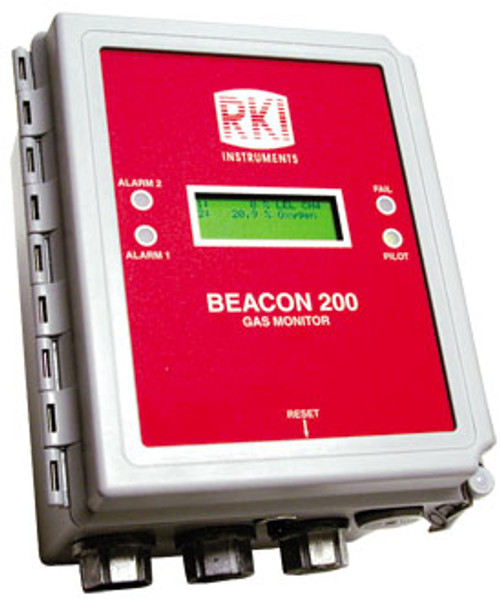TWO GAS FIXED SYSTEM with BEACON 200 Controller/M2A Series Sensors
The System includes the controller and up to two sensors
Click here to learn more about the RKI Instruments Beacon 200 Controller Assembly
Click here to learn more about the RKI Instruments M2A Series sensors/transmitters
Beacon 200 Two Channel Wall Mount Controller
Description
The Beaconª 200 is a powerful, low cost fixed system controller for two points of gas detection. It is microprocessor controlled, versatile, simple to install and operate, and priced to be the industry’s most economical two point controller. It is capable of connecting directly to RKI sensors for LEL level combustibles, Oxygen, Hydrogen Sulfide, or Carbon Monoxide. The Beaconª 200 can also accept any 4-20 mA transmitter (2 or 3 wire, 24 VDC). Sensors can be mounted directly at the Beaconª 200 housing, or can be wired remotely from the controller.The 10 amp rated relays are strong enough to actuate most external alarms and horns without using slave relays. The digital display has backlighting and simultaneous readout of the gas type and concentration.The Beaconª 200’s housing is rated NEMA 4X for corrosion resistance and a weather tight seal, and complies with lock out / tag out standards. An external reset switch allows the alarm to be silenced from outside of the controller housing. The Beaconª 200 comes complete with a wall mounting kit for easy installation.RKI offers the industry’s widest selection of standard and toxic gas detection sensors, which can be utilized with the Beaconª 200, providing gas monitoring protection for almost any application.Features
- Simultaneous readout on 2 channels
- Two alarm levels per channel
- Discrete and common relays
- NEMA 4X enclosure
- 4-20 mA outputs
- Proven, long-life sensors for a wide variety of gases
- Accepts any 4-20 mA transmitter input (24 VDC)
- Easy to install, operate and expand
M2A Series Stand Alone Explosion Proof Transmitter
DescriptionThe RKI M2A™ is a state-of-the-art transmitter that can operate as an independent, stand-alone monitor or as part of an integrated system. The M2A connects with an analog or digital signal to virtually any controller, PLC, or DCS. Setup procedures are simplified with user friendly push buttons and OLED menus. It utilizes a magnetic wand technique for performing non-intrusive calibration. The M2A provides an automatic zero drift correction feature, which results in more stable readings and reduces the need for adjustments due to sensor aging.The housing of the M2A does not need to be opened for zeroing or calibration, making it unnecessary to declassify the area for routine maintenance. It is designed so that a complete field calibration can be performed by one person. Sensor construction is rated Class I, Div. 1 Groups B, C, D for flammables, CO, H2S, O2, and CO2, and Class I, Div. 2 for all other toxics.The transmitter provides a 4-20 mA output in addition to a Modbus digital output. It also has two levels of alarms with relays, plus a fail alarm with relay. A digital display of the gas concentration, as well as alarm and status lights, can be viewed through the front window.The toxic sensors are electrochemical type plug-in sensors, which provide high specificity, fast response, and long life. The plug-in design allows quick replacement in the field with no tools required. Toxic sensors are designed for use in Class I, Div. 2 hazardous locations. Sensors available for NH3, SO2, PH3, AsH3, and HCN.The M2A represents the latest leading edge technology in sensor / transmitters today.
Features
- Operates with or without a controller
- Direct digital readout with OLED
cold temperature display
- LEL, O2, H2S, CO, CO2,Infrared sensor for combustibles
- 100% Vol CH4, and 0-9,000 PPM CH4
- Toxic Gases include NH3, SO2, HCN, and more
and CO2- 4-20 mA & digital Modbus outputs standard
- 2 fully programmable alarm relays & fail relay
- Non-intrusive calibration via magnetic wand
- Explosion proof construction
- Patented water repellent sensor cover
- User friendly setup, push buttons & OLED
menus
- Long-life sensors (2+ years typical)







